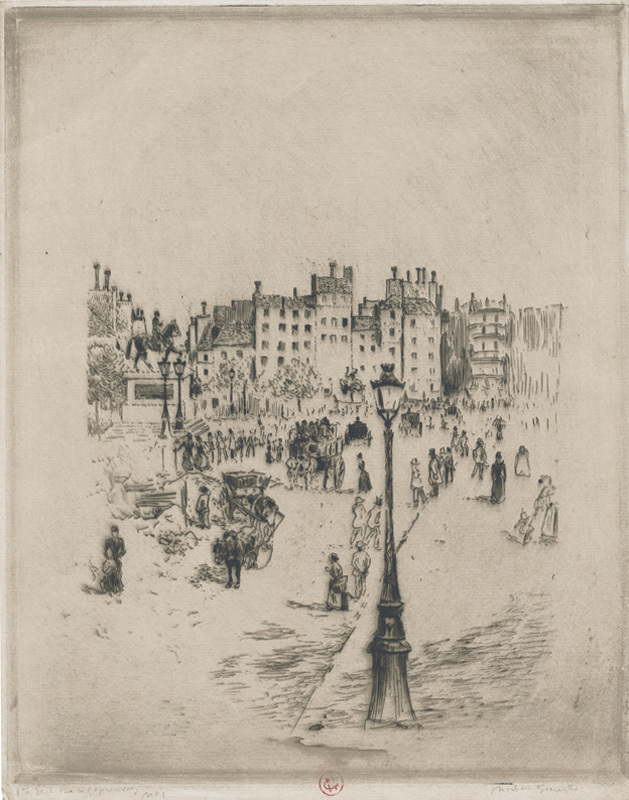
19th, 20th & 21st Century Fine Prints
707-546-7352 · fax 707-546-7924 · web: www.annexgalleries.com · email: artannex@aol.com
Le Pont Neuf (grande planche) by Norbert Goeneutte

Le Pont Neuf (grande planche)
Norbert Goeneutte
Le Pont Neuf (grande planche)
Norbert Goeneutte
1854 - 1894 (biography)Goeneutte produced a number of etchings in his short life span of forty years including two of the Pont Neuf, both done in 1877. The image that preceded this is smaller in size and included aquatint.
In the catalogue raisonné by Beraldi neither print is included in the list of 101 works. There are a few mentions of impressions in a few collections but this is a rare print, especially in this state. In later states the plate was trimmed on both the right, left and top, from 10-3/16 x 8-3/16" to 9-9/16 x 6-3/8." Like Whistler, Goeneutte trimmed the margins of this impression.
James McNeill Whistler did a number of etchings of bridges from various angles and inspired a generation of printmakers to focus on architectural imagery as interesting compositions rather than just their grandeur. In this intaglio Goeneutte focused on the activity on the bridge itself, in the background the equestrian statue of Henry IV can be seen.
The "Pont Neuf" (New Bridge) was begun in 1578 and, despite its name, is the oldest bridge spanning the Seine in Paris. The bridge is composed of two separate spans, one of five arches joining the left bank to the Île de la Cité, another of seven joining the island to the right bank. The total length of the bridge is 760 feet and the width is 72 feet.
Norbert Goeneutte was born in Paris, France, on July 23, 1854. He was enrolled in the prestigious Lycée Condorcet high school when the Franco-Prussian war broke out, followed by the Commune, and he was sent away for his protection. He finally graduated in 1871 and, despite an interest in art, was sent by his father to work for an attorney's office.
After his father's death shortly thereafter, he enrolled in the École des Beaux-arts to study under Isidore Pils. After Pils' death In 1875, and finding himself dissatisifed with the new professor, Goeneutte left the school to set up his own studio in Montmartre and immerse himself in the lively Paris art scene. Befriended by Édouard Manet, he was soon welcomed into the circle of Impressionists that frequented the famous Cafe de la Nouvelle Athènes, including Pissarro, Van Gogh, Degas, and Renoir, for whom he would model for several paintings.
Around 1875 he was introduced to intaglio printmaking by Marcellin Desboutin, and the medium would soon become as preferred as oils. He began exhibiting at the Paris Salon, gaining critical acclaim for the painting "The Boulevard de Clichy Under Snow" in 1876. Despite his association with Paris' most controversial and celebrated artists of the time, he chose not to participate in the major Impressionst exhibitions that would become landmarks of change, preferring instead the Salon's traditional venue. In 1889 he cofounded the Société des peintres-graveurs français along with Félix Braquemond and Henri Guérard.
Goeneutte traveled extensively, sketching the landscapes and street scenes of Italy, England, the Netherlands, and much of rural France. However in 1891 Goeneutte was diagnosed with a weak heart, possibly due to undetected tuberculosis, and was directed to end his travels and move to the countryside. His doctor, the artist and art patron Paul Gachet, found him a house near his own in Auvers-sur-Oise, where Goeneutte settled with his mother and siblings. There, he became acquainted with an artist's group headed by Charles-François Daubigny, and worked on a series of engraved illustrations for the periodical La Renaissance littéraire et artistique with Gachet. Goeneutte was working on illustrations for Émile Zola's book La Terre when he died on October 9, 1894 due to his prolonged illness.
